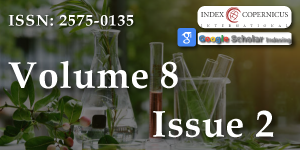Are Biofungicides a Means of Plant Protection for the Future?
Main Article Content
Abstract
Biofungicides are prepared based on living micro/organisms or on matters prepared from them. They are based on the antagonism of fungal pathogens and their antagonists. Their effect depends on weather conditions (temperature and moisture) in comparison with chemical fungicides which are effective in all conditions but they let the residues in plants, animals, and men. The future of agriculture will be pure food without chemicals.
Article Details
Copyright (c) 2024 Vavera R, et al.

This work is licensed under a Creative Commons Attribution 4.0 International License.
The Journal of Plant Science and Phytopathology is committed in making it easier for people to share and build upon the work of others while maintaining consistency with the rules of copyright. In order to use the Open Access paradigm to the maximum extent in true terms as free of charge online access along with usage right, we grant usage rights through the use of specific Creative Commons license.
License: Copyright © 2017 - 2025 |  Open Access by Journal of Plant Science and Phytopathology is licensed under a Creative Commons Attribution 4.0 International License. Based on a work at Heighten Science Publications Inc.
Open Access by Journal of Plant Science and Phytopathology is licensed under a Creative Commons Attribution 4.0 International License. Based on a work at Heighten Science Publications Inc.
With this license, the authors are allowed that after publishing with the journal, they can share their research by posting a free draft copy of their article to any repository or website.
Compliance 'CC BY' license helps in:
| Permission to read and download | ✓ |
| Permission to display in a repository | ✓ |
| Permission to translate | ✓ |
| Commercial uses of manuscript | ✓ |
'CC' stands for Creative Commons license. 'BY' symbolizes that users have provided attribution to the creator that the published manuscripts can be used or shared. This license allows for redistribution, commercial and non-commercial, as long as it is passed along unchanged and in whole, with credit to the author.
Please take in notification that Creative Commons user licenses are non-revocable. We recommend authors to check if their funding body requires a specific license.
Fenta L, Mekonnen H. Microbial Biofungicides as a Substitute for Chemical Fungicides in the Control of Phytopathogens: Current Perspectives and Research Directions. Scientifica (Cairo). 2024 Feb 28; 2024:5322696. doi: 10.1155/2024/5322696. PMID: 38449800; PMCID: PMC10917481.
Gikas GD, Parlakidis P, Marsopoulos T, Vyzas Z. Particularities of Fungicides and factor Affecting Their Fate and Removal Efficacy: A Review 2022. Sustainability. 2022;14(7):4056.
Abbey JA, Percival D, Abbey L, Asied S, Prithiviraj K, Schilder A. Biofungicides as alternative to synthetic fungicide control of grey mould (Botrytis cinerea) – Prospects and challenges. Biocontrol Sci and Technol. 2019; 29:207-228.
Ridout ME, Godfrey B, Newcombe G. Effects of Antagonists on Mycotoxins of Seedborne Fusarium spp. in Sweet Corn. Toxins (Basel). 2019 Jul 25;11(8):438. doi: 10.3390/toxins11080438. PMID: 31349594; PMCID: PMC6723472.
Gramaje D, Aroca A, So R, García-Jiménez J, Armengol. Evaluation of fungicide to control Petri disease pathogens in the grapevine propagation process.Crop Protection. 2009; 28:12; 1091- 1097.
Da Rocha MEB, Freire FCO, Maia FEF, Guedes MIF, Rondina D. Mycotoxins and their effects on human and animal health. Food Control. 2014; 36:1; 159-165.
Hýsek J, Vach M, Brožová J, Sychrová E, Civínová M, Nedělník J, Hrubý J. The influence of the application of mineral fertilisers with the biopreparations Supresivit (Trichoderma harzianum) on the health and the yield of different Crops.Archiv Phytopath. Pflanz. 2002; 35:115-124.

